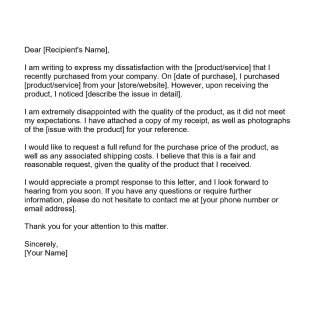Complaint letter
A complaint letter is a formal document used to express dissatisfaction or grievances with a product or service. Its main purpose is to communicate a problem, request a resolution or compensation, and maintain a record of the issue.
A complaint letter typically consists of the following parts:
- Date: the date the letter is written
- Sender's contact information: name, address, phone number, and email address
- Recipient's contact information: name, title, company name, and address
- Salutation: the greeting to the recipient
- Body: the main content of the letter, which includes a description of the issue, the impact it had, and any supporting evidence or documentation
- Request for resolution: a clear and concise statement of what the sender wants the recipient to do to resolve the issue
- Closing: a polite closing statement, such as "sincerely" or "best regards," followed by the sender's signature
Important fields to consider when compiling a complaint letter include the sender's contact information, the recipient's contact information, and a clear description of the issue. It is also important to include any supporting evidence or documentation, such as receipts, invoices, or photographs.
When compiling a complaint letter, it is important to be clear and concise, and to avoid making personal attacks or using offensive language. It is also important to consider the tone of the letter, as a polite and professional tone is more likely to result in a positive outcome.
Sample Complaint letter
Dear [Recipient's Name],
I am writing to express my dissatisfaction with the [product/service] that I recently purchased from your company. On [date of purchase], I purchased [product/service] from your [store/website]. However, upon receiving the product, I noticed [describe the issue in detail].
I am extremely disappointed with the quality of the product, as it did not meet my expectations. I have attached a copy of my receipt, as well as photographs of the [issue with the product] for your reference.
I would like to request a full refund for the purchase price of the product, as well as any associated shipping costs. I believe that this is a fair and reasonable request, given the quality of the product that I received.
I would appreciate a prompt response to this letter, and I look forward to hearing from you soon. If you have any questions or require further information, please do not hesitate to contact me at [your phone number or email address].
Thank you for your attention to this matter.
Sincerely,
[Your Name]
Examples of application and use cases of complaint letters include filing a complaint to a company for poor service, a complaint to a landlord for maintenance issues, or a customer service complaint to a product manufacturer for a defective product.
The benefits of using a complaint letter include the ability to document the issue, request a resolution or compensation, and maintain a professional and respectful approach. However, the challenges and risks of using a complaint letter include the possibility of not receiving a response or resolution, or of receiving a negative response.
Related and alternative forms to a complaint letter may include a phone call, an email, or a social media post. However, a complaint letter provides a more formal and structured approach that can be used as evidence in case of legal proceedings.
The form affects the future of the participants by providing a clear record of the issue and the steps taken to resolve it. The form is typically submitted via mail or email, and should be stored in a safe and accessible location for future reference.
In summary, a complaint letter is a formal document used to express dissatisfaction or grievances with a product or service. It is important to be clear and concise, avoid personal attacks or offensive language, and maintain a polite and professional tone. The form provides a clear record of the issue and the steps taken to resolve it, and can be used as evidence in legal proceedings.

